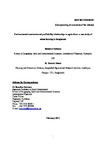Environmental constraints and profitability relationships in agriculture: a case study of wheat farming in Bangladesh
Date
2011-11-01Author
Subject
Metadata
Show full item recordAbstract
This article attempts to measure the influence of environmental constraints on profitability and resource use in agriculture by utilizing survey data of 293 wheat farmers from three regions of Bangladesh. Analysis is based on a profit function, where the selected variables representing environmental constraints were incorporated as additional fixed factors. Results revealed that environmental constraints have a significant influence on both profitability and farmers' resource allocation decisions. Output supply and input demands were significantly affected by land suitability and other environmental constraints (i.e. a combination of poor soil fertility, pest and weed infestation and weather variation). The policy implications include development of wheat varieties that are suitable for low lying and/or marginal areas, are resistant to insect and pest attacks and can withstand weather variations. Also, soil fertility improvement through soil conservation and crop rotation, improvement in managerial practices through extension services and strengthening of research-extension link will improve profitability. © 2011 Taylor & Francis.
Publisher
Journal
Volume
Issue
Pagination
Recommended, similar items
The following license files are associated with this item:


